60. The 25th
Chinese station Star was at Alphard, which my
ear tells me ought to mean 'the Horse' (cfr for instance
German das Pferd).
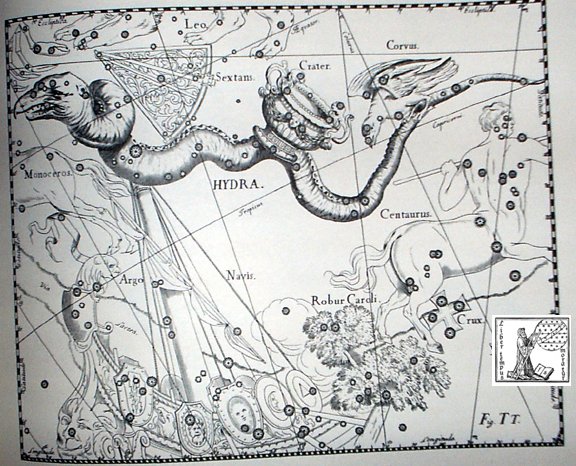
|
June solstice |
|
22 |
Well |
μ Gemini (Tejat Posterior) |
Tapir |
(95.4) |
Jun 24 (175) |
175 = 164
+ 11 |
|
23 |
Ghost |
ρ Gemini ? |
Goat |
(112.1) |
Jul 11 (192) |
192 = 175
+ 17 |
|
24 |
Willow |
δ Hydrae |
Stag |
(129.6) |
Jul 28 (209) |
209 = 192
+ 17 |
|
25 |
Star |
α Hydrae (Alphard) |
Horse |
(142.3) |
Aug 10 (222) |
222 = 209
+ 11 |
|
26 |
Extended Net |
ε Hydrae / μ Hydrae |
Ox |
(131.9 / 157.1) |
Jul 30 (211) /
Aug 25 (237) |
237 = 222
+ 15 |
|
27 |
Wings |
α Crateris (Alkes) |
Snake |
(165.6) |
Sep 2 (245) |
245 = 237
+ 8 |
|
28 |
Chariot |
γ Corvi (Gienah) |
Worm |
(185.1) |
Sep 22 (265) |
265 = 245
+ 20 |
|
MAY 29 |
30 |
31
(151) |
JUNE 1 |
2 (*73) |
3 |
4 |
 |
 |
 |
 |
 |
 |
 |
|
Ga3-10 |
Ga3-11 |
Ga3-12 |
Ga3-13 (72) |
Ga3-14 |
Ga3-15 |
Ga3-16 |
|
γ
Pyxidis
(133.6) |
ζ Hydrae
(134.1), ρ Cancri (134.2), ζ Oct.
(134.3), ο Cancri (134.6),
δ
Pyxidis
(134.9) |
ACUBENS = α Cancri,
TALITHA
BOREALIS = ι Ursae Majoris
(135.0), σ Cancri (135.2), ρ Ursa
Majoris (135.6) |
ν Cancri (136.0),
TALITHA
AUSTRALIS
= κ Ursae Majoris
(136.1),
ω Hydrae
(136.8) |
9h (137.0)
σš Ursa Majoris (137.0), κ Cancri
(137.3), τ Cancri (137.4),
ALSUHAIL
= λ Velorum
(137.5), σ˛ Ursa Majoris (137.6), τ Ursa
Majoris (137.7),
ξ
Cancri
(137.8) |
κ
Pyxidis
(138.0),
ε
Pyxidis
(138.5) |
π Cancri (139.2),
MIAPLACIDUS = β Carinae
(139.3),
TUREIS
= ι Carinae
(139.8) |
|
August 1 |
2 |
3 (*500) |
4 (216) |
5 |
6 |
7 |
|
°July 28 |
29 (*130) |
30 |
31 |
°August 1 |
2 (214) |
3 |
|
'July 5 |
6 (*107) |
7 |
8 |
9 (190) |
10 |
11 |
|
SOLSTICE |
"June 22 (*93) |
23 |
ST JOHN'S DAY |
Maro 25 |
26 (177) |
27 |
|
NAKSHATRA DATES: |
|
NOVEMBER 28 |
29 |
30 (*254) |
DECEMBER 1 |
2 (336) |
3 |
4 |
|
μ
Aquarii
(316.0) |
ε Equulei
(317.8) |
no star
listed (318) |
21h (319.6)
ARMUS =
η Capricorni
(319.0),
DORSUM
= θ
Capricorni
(319.3),
TSOO
= 24 Capricorni
(319.7) |
DRAMASA = σ Oct.,
χ
Capricorni
(320.0),
ν
Aquarii
(320.3), γ Equulei (320.6), ο
Pavonis (320.8) |
α Oct.
(321.5), δ Equulei (321.7), φ Capricorni
(321.8) |
KITALPHA = α Equulei
(322.0),
ALDERAMIN = α Cephei
(322.9) |
|
January 31 |
February 1 |
2 |
3 |
4 (400) |
5 (36) |
6 |
|
°January 27 |
28 |
29 (*314) |
30 |
31 (396) |
°February 1 |
2 |
|
'January 4 |
5 (*290) |
6 |
7 (372) |
8 |
9 |
10 |
|
SOLSTICE |
"December 22 |
23 |
X-MAS EVE |
25 |
26 (360) |
27 |
... Ancient references to a south pole are of course
infrequent; Ovid, howevever, makes Phoebus allude to
it in his instructions to Phaëton ... and Pliny
tells us that the Hindus had given it a name,
Dramasa
...
|
JUNE 5 (2 * 78) |
6 (157 = 314 / 2) |
 |
 |
|
Ga3-17 |
Ga3-18 (77) |
|
no star listed (140) |
θ
Pyxidis
(141.5),
MARKAB
VELORUM = κ Velorum
(141.5),
AL MINHAR AL ASAD
= κ Leonis
(141.6),
λ
Pyxidis
(141.9) |
|
August 8 (220) |
9 |
|
°August 4
(216) |
5 |
|
'July 12 (193) |
13 (*114) |
|
"June 28 (*99) |
29 (180) |
Possibly Star was meant to point
at Sirius, which at the time of Bharani should have been at
Alphard.
The Knot of the neck of the Hydra
would at all times have forced the fluid through this water pipe
(cfr the German name Grosse Wasserschlange
for the Hydra constellation) to subside, but at the
time of Bharani Sirius could have caused new fresh
water to return.
... There is a wide range of significations in this
stem [mata]. It will serve to express an
opening as small as the mesh of a net or as large as
a door of a house; it will serve to designate
globular objects as large as the eye or as small as
the bud on a twig or the drop of rain, and
designating a pointed object it answers with equal
facility for the sharpened tip of a lance or the
acres of a headland; it describes as well the edge
of a paddle or the source from which a thing
originates ...
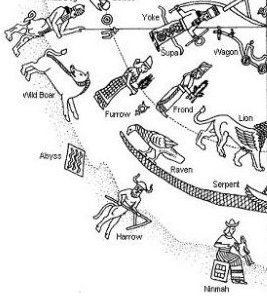
...
Actually, we are up against a completely
incomprehensible narrative of events which occurred
during a sea voyage. The plant, according to
Albright (AJSL 36, p. 281, n. 2) literally
'thorny grapevine' is supposed to grow in the
apsu, and to be accessible by way of a
'water-pipe'. This pipe, rātu, however, is a
conjecture right here: the word occurs only later
when, after his bath in a well, and the following
loss of the plant, Gilgamesh complains bitterly
about his frustration, i.e., about having obtained a
boon for the 'earth lion' instead of for himself.
The 'earth lion', identified with the thievish
serpent, is assumed in its turn to live 'in a well
which communicated with the apsu' (Albright,
35, p. 194).
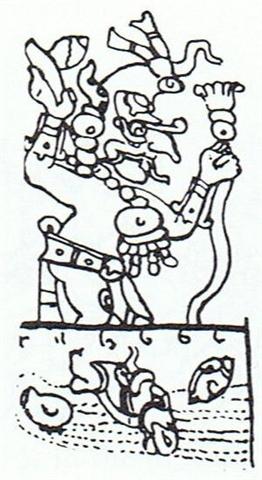
It is then (GE 11.298)
that the hero says: 'When I opened the water-pipe
and (...) the gear, I found that which has been
placed as a sign for me: I shall withdraw and leave
the boat on the shore' (Speiser trans., ANET, pp.
96f.) ...
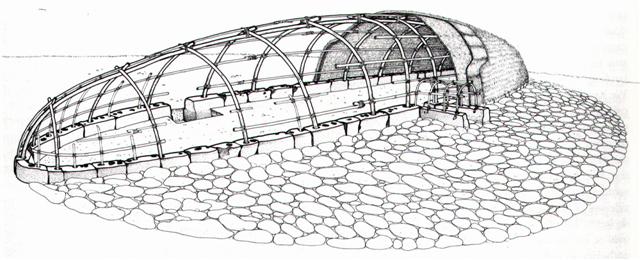
As I remember it from Van Tilburg
most of the ruins of the hare paega houses
(overturned boats) were spread out
over the northern slope of Rano Kau (Kao).
| Kao
1. Side, edge, rim; kao
gutu (or just kao), labia minora.
2. Steep, almost perpendicular; thin,
skinny. Motu Kaokao, name of one of
the islets opposite Orongo, with a
steep shape. Vanaga.
Cloth, clothing, garb.
(Perhaps a variant of kahu.)
Kaokao, side, flank, ribs, lateral. P
Pau.: kaokao, the side, flank. Mgv.:
kaokao, the side, flank. Mq.:
kaokao, id. Ta.: aoáo, id. In
Nuclear Polynesia this is particularized, in
Samoa to the armpit, in Tonga and Futuna to
the sides of the canoe. Therefore it may be
considered a borrowing from the Tongafiti.
Churchill. |
| Kau
1. To move one's feet
(walking or swimming); ana oho koe, ana
kau i te va'e, ka rava a me'e mo kai, if
you go and move your feet, you'll get
something to eat; kakau (or also
kaukau), move yourself swimming. 2. To
spread (of plants): ku-kau-áte kumara,
the sweet potatoes have spread, have
grown a lot. 3. To swarm, to mill around (of
people): ku-kau-á te gagata i mu'a i tou
hare, there's a crowd of people milling
about in front of your house. 4. To flood
(of water after the rain): ku-kau-á te
vai haho, the water has flooded out (of
a container such as a taheta). 5. To
increase, to multiply: ku-kau-á te moa,
the chickens have multiplied. 6. Wide,
large: Rano Kau, 'Wide Crater' (name
of the volcano in the southwest corner of
the island). 7. Expression of admiration:
kau-ké-ké! how big! hare kau-kéké!
what a big house! tagata hakari
kau-kéké! what a stout man! Vanaga.
To bathe, to swim;
hakakau, to make to swim. P Pau., Mgv.,
Mq.: kau, to swim. Ta.: áu,
id. Kauhaga, swimming. Churchill.
The stem kau does not appear
independently in any language of Polynesian
proper. For tree and for timber we have the
composite
lakau in various stages of
transformation. But kau will also be
found
as an initial component of various tree
names. It is in Viti that we first find it
in free existence. In Melanesia this form is
rare. It occurs as kau in Efaté,
Sesake, Epi, Nguna, and perhaps may be
preserved in Aneityum; as gau in
Marina; as au in Motu and somewhere
in the Solomon islands. The triplicity of
the Efaté forms [kasu, kas,
kau] suggests a possible transition.
Kasu and kas are easy to be
correlated, kasu and kau less
easy. They might be linked by the assumption
of a parent form kahu, from which
each might derive. This would appear in
modern Samoan as kau; but I have
found it the rule that even the mildest
aspirate in Proto-Samoan becoming extinct in
modern Samoan is yet retained as aspiration
in Nuclear Polynesia and as th in
Viti, none of which mutations is found on
this record. Churchill 2. |
When the old water source had run
down
a new one had to be located. Looking at the Full Moon
it ought to have been quite clear where such a new source
should
be:
|
JUNE 5 (2 * 78) |
6 (157 = 314 / 2) |
 |
 |
|
Ga3-17 |
Ga3-18
(77) |
|
NAKSHATRA DATES: |
|
DECEMBER 5 |
6 (340) |
|
DAI
= ι Capricorni
(323.5), β Equulei (323.8) |
γ
Pavonis (324.1),
YAN
= ζ Capricorni
(324.6) |
|
February 7 (403) |
8 (*324) |
|
°February 3 (399) |
4 (*320) |
|
'January
11 (*296) |
12 (377) |
|
"December 28 (*282) |
29 (363) |
|
JUNE 7 (*78) |
8 |
9 |
10 (161) |
11 |
12 |
 |
 |
 |
 |
 |
 |
|
Ga3-19 (78) |
Ga3-20 |
Ga3-21 |
Ga3-22 |
Ga3-23 |
Ga3-24 |
|
NAKSHATRA DATES: |
|
DECEMBER 7 |
8 |
9 |
10 |
11 (345) |
12 (*266) |
|
BUNDA
(Foundation) / KAKKAB
NAMMAΧ (Star of Mighty Destiny) |
θ Piscis Austrini
(330.1), λ
Oct. (330.7) |
|
Al Sa'd al Su'ud-22 /
Emptiness-11
TSIN = 36 Capricorni
(325.2),
ALPHIRK = β Cephei
(325.7),
SADALSUD = β
Aquarii,
ξ Gruis (325.9) |
no star
listed (326) |
CASTRA = ε Capricorni
(327.2),
BUNDA
= ξ Aquarii
(327.5) |
Mahar sha
hi-na Shahū-26 (Western One in the
Tail of the Goat)
NASHIRA = γ Capricorni
(328.0), ν Oct. (328.3),
AZELFAFAGE = πš
Cygni,
κ Capricorni (328.7) |
Arkat sha
hi-na Shahū-27 (Eastern One in the
Tail of the Goat)
ENIF (the Nose) = ε Pegasi,
ERAKIS = μ Cephei
(329.2),
46
Capricorni, JIH (the Sun) = κ Pegasi
(329.3), ι Piscis Austrini (329.4), λ
Capricorni (329.6), ν Cephei (329.7),
DENEB
ALGIEDI = δ Capricorni
(329.8) |
|
February 9 (40) |
10 |
11 (407) |
12 |
13 (*329) |
All Hearts' Day |
|
°February 5 |
6 |
7 |
8 (*324) |
9 (40) |
10 |
|
'January 13 (378) |
14 |
15 (*300) |
16 |
17 |
18 (383) |
|
"December 30 |
31 (*285) |
"January 1 |
2 |
3 (368) |
4 |
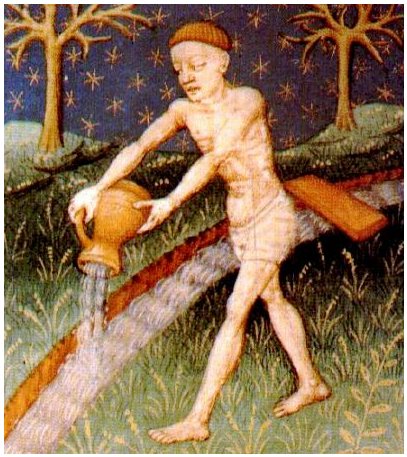
|











